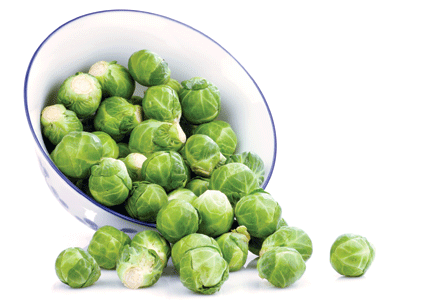
Brussel sprouts are a good source of vitamins C and K plus a host of other nutrient benefits. Try our Brussel sprout recipes.
They look like mini-cabbages. They belong to the Brassicas—a plant family that includes cabbage, kale, and cauliflower—all remarkably healthy nutritional choices. Yet Brussels sprouts remain, unfairly, among those foods we love to hate.
Blame it on the sulphur compounds present in this group of vegetables and also on the tendency to under- or overcook them. But when properly prepared, Brussels sprouts are both delicious and invigorating foods to eat.
Health benefits
One of the reasons for Brussels sprouts’ huge health punch is that they are nutritionally loaded.
Vitamin C
One cup of Brussels sprouts contains over 160 percent of the recommended daily intake of vitamin C, which plays a protective role in our body against cardiovascular diseases, cancers, joint diseases, and cataracts.
Vitamin K
At 273 percent of daily value, vitamin K is a big reason that Brussels sprouts are such a valuable vegetable. Vitamin K is getting plenty of attention recently as researchers discover more about its importance for normal blood clotting, maintaining bone health, preventing calcification of blood vessels, and preventing liver and prostate cancer.
Sulphoraphane
A phytonutrient formed in Brussels sprouts when the leaves are chopped or chewed, sulphoraphane boosts our body’s natural detoxification enzymes and can help clear cancer-causing substances from our system.
Studies have indicated sulphoraphane may also inhibit the growth of colon cancer and help control the spread of late-stage breast cancer cells.
Indole-3-carbinol
Another phytonutrient found in cruciferous vegetables such as Brussels sprouts, indole-3-carbinol can help decrease the amount of circulating LDL cholesterol that contributes to the formation of plaque deposits in arteries.
Just give ’em a try
As a small demonstration that can change the way you feel about Brussels sprouts, try this simple method of preparation
- Slice the bases off several sprouts and peel off individual leaves. The centre of the sprout is too tightly furled to peel so slice this part thinly.
- Place the leaves in a steamer over boiling water for 30 seconds, then transfer to a bowl.
- Add a sprinkle of sea salt and a twist of fresh ground pepper, then finish with a dash of good-quality extra-virgin olive oil and toss to coat.
Each 1 cup (250 mL) serving contains: 61 calories; 4 g protein; 8 g total fat (0.16 g sat. fat, 0 g trans fat); 13.5 g carbohydrates; 4 g fibre; 32.75 mg sodium
Choosing, storing, and handling
Size: Harvested sprouts can vary from 1/2 in (1.25 cm) for baby sprouts to 1 1/4 to 2 in (1.3 to 5 cm) for standard size. Smaller ones are less pungent and more tender. When selecting, choose sprouts that are the same size for even cooking.
Availability: In most areas Brussels sprouts are harvested as a fall/early winter crop, when the flavour is at its best. Like their cousin, kale, they are a bit sweeter after a mild frost.
Colour: Select sprouts that are bright in colour and whose leaves are tightly furled. Colour can vary through different shades of green; a reddish purple variety called Rubine is increasingly available.
Texture: The head should feel firm and dense with no air pockets.
Storage: Unlike cabbage, Brussels sprouts do not store well for more than a week, so purchase them as close as possible to your planned use. Keep loose sprouts refrigerated in a plastic or glass container with paper towel.
Preparation: Trim off the discoloured base, peel away any yellowed leaves, and rinse well before cooking. Larger sprouts will cook more uniformly if you halve or quarter them first. Many of the stronger volatile compounds that we associate with this family of vegetables are concentrated in the centre of the base and core, so trimming this area off can help reduce these aromas and flavours from overpowering their innate goodness.
Cooking: Unless you are preparing them raw, it is usually beneficial to boil or steam Brussels sprouts briefly first before finishing the recipe. This helps to make them more tender and leaches out the powerful sulphurous compounds.
Nutrient levels for 1 cup (250 mL) of boiled Brussels sprouts
| Nutrient | Amount | Daily value (percent) |
|
vitamin K |
218.80 mcg |
273 |
Source: USDA National Nutrient Database
Recipes
- Mediterranean Sauté
- Caramelized Fennel and Onions with Brussels Sprouts and Toasted Walnuts

